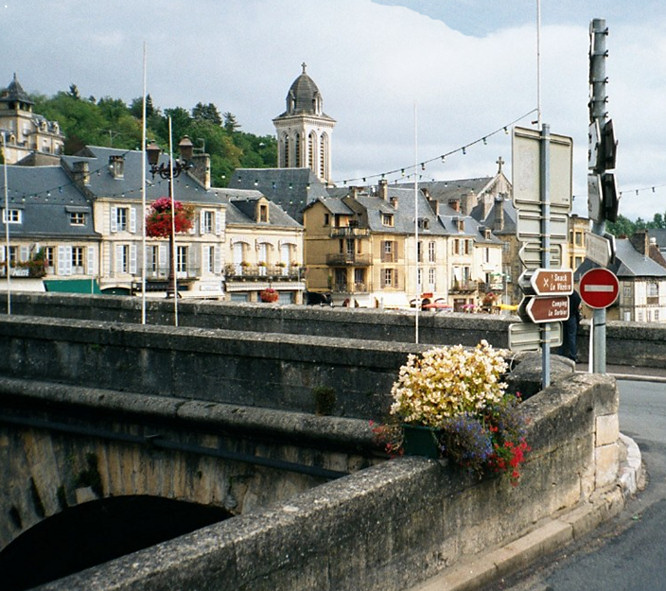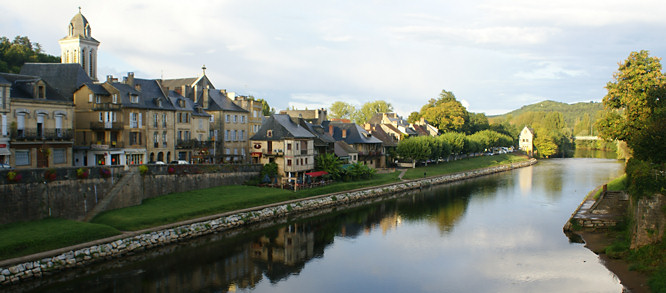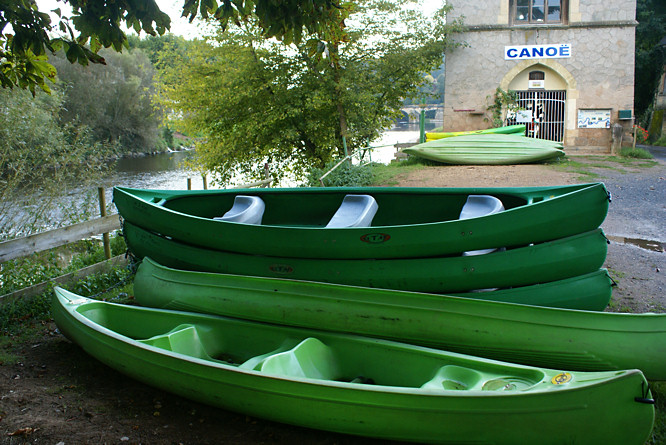Montignac in the Dordogne
Montignac is a pretty working town on the banks of the Vezere River (pronounced Viz-air) 30km north of Sarlat. It has been slightly blighted by too much modern overdevelopment on its outskirts, but the attractive balconied houses along the river front, and the ancient half timbered buildings of the old town backstreets make it worth a stop.

The bridge over the river Vezere was the impetus for the town's growth and prosperity. Because of the risk of flooding the town was built higher up on the valley slope and not on the rivers edge. You can see flood height markers by the water and on some buildings. Initial impressions of Montignac were a little disappointing because we had been use to the yellow sandstone fairy tale medieval buildings of places like Sarlat and Bergerac.
My assessment changed as I started to explore the town on foot. I enjoyed walking along the grass verges of the riverbank. Being down low you look up at the town buildings and they look more impressive. There are some unusual balconied houses on the west bank designed to cope with the rising height of the river. One of them looks more Swiss than French.

In the summer attractive colourful flower boxes line river bank wall and are affixed to some of the houses. It show that the locals care about the appearance of their town. This civic pride can also be seen by the way the large car park at the northern end of the town on the west bank of the river, has been landscaped with lots of tree planting to soften its look.
It is a favourite overnight location for many RV campervans. Near the car park and the northerly more modern Montignac bridge there is a place where you can hire canoes. On a hot summers day I cannot think of anything more enjoyable than playing on the water. You can arranged to canoe down river and get picked up by a van so as to avoid the effort of having to paddle up steam against the current.

Spend time walking around the charming streets, shops and riverside restaurants of the east bank of Montignac. This area pleasantly contrasts with the 600 year old half timbered medieval merchant houses hidden in the back streets of the west bank area of Montignac behind the more modern buildings and shops that now line the riverbank.
If you just drive through Montignac on the main road you will miss them. You have to park and walk. You cannot see them in the above photograph. They are tucked in behind that row of houses. The Chateau de Montignac is in the town - once a very important castle in the region, but now largely in ruins. Montignac hosts the Festival of Folklore de Montignac at the end of July.
Lascaux caves
The Neolithic caves at Lascaux are found near Montignac. The paintings in Lascaux caves date from the period around 17,000 years ago, The caves were occupied for a long period. They were discovered in 1940 by a group of teenagers who were searching for their dog.
The cave paintings at Lascaux are mostly pictures of large animals the residents liked to hunt. There are also some carvings of animals to be seen. In total there are more than 1000 images in the cave system. There are also a few images of people, most notably in a sequence that seems to represent a bison hunt.

Perhaps most interesting of all, they include the 'auroch', an early relative of the ox that is now extinct. It is believed that the Auroch was a sacred beast in prehistoric times. Another curiosity is the painting of a creature with two long straight horns, not identified as a real animal and known as the licorne.
After the end of the second world war the caves were opened to the public, but had to be closed in 1963 because the paintings were being damaged by the breath of thousands of visitors. A copy was created nearby so that visitors to Lascaux could still appreciate the caves. Known as Lascaux II, the 'reproduction' caves are a copy of most of the prehistoric paintings contained in the original Lascaux caves, 200 metres away. As far as possible the same materials - natural pigments etc - and techniques have been used for the copies as for the originals.
Travel books

